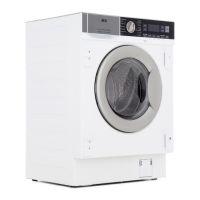
Do you have a question about the AEG L7WC8632BI and is the answer not in the manual?
| Door hinge | Left |
|---|---|
| Drum volume | 52 L |
| Loading type | Front-load |
| Product color | White |
| Built-in display | Yes |
| Custom panel-ready | - |
| Appliance placement | Built-in |
| Annual water consumption washing | 11200 L |
| Annual energy consumption washing | 194 kWh |
| Annual water consumption washing & drying | 23000 L |
| Annual energy consumption washing & drying | 1060 kWh |
| Drying capacity | 84 kg |
| Washing capacity | 8 kg |
| Residual moisture | 44 % |
| Maximum spin speed | 1600 RPM |
| Noise level (spin) | 70 dB |
| Noise level (wash) | 46 dB |
| Noise level (drying) | 52 dB |
| Inlet hose length | 1.5 m |
| Outlet hose length | 1.4 m |
| Connected load | 2000 W |
| AC input voltage | 230-240 V |
| AC input frequency | 50 Hz |
| Energy efficiency scale | A to G |
| Energy consumption washing per cycle | 0.97 kWh |
| Water consumption washing & drying per cycle | - L |
| Energy consumption washing & drying per cycle | 5.3 kWh |
| Depth | 540 mm |
|---|---|
| Width | 596 mm |
| Height | 819 mm |
Safety guidelines for appliance use by children and individuals with reduced capabilities, focusing on supervision.
Covers general safety precautions for appliance usage, installation, and electrical/water connections.
Details on proper installation procedures, including placement, ventilation, and securing the appliance.
Guidelines for safe electrical hookup, including earthing, socket types, and cable handling.
Instructions for connecting the water supply hoses safely, ensuring no damage or leaks.
Precautions to take while operating the appliance, such as avoiding flammable items and hot surfaces.
Guidelines for servicing, using original parts, and safely disposing of the appliance and its components.
Identification of appliance parts and steps for safely unpacking and preparing for installation.
Guidance on installing on suspended floors, positioning, and levelling the appliance for stability.
Detailed instructions for connecting the water inlet hose and drain hose, and managing the mains cable.
Methods and requirements for connecting the drain hose to a stand pipe, sink spigot, or wall pipe.
Instructions for integrating into furniture and fitting the anti-tilting accessory for stability.
Steps for preparing and attaching a cupboard door to the appliance, including hinge adjustments.
Diagram and identification of the main components and features of the washing machine.
Explanation of the control panel layout, buttons, indicators, and their functions.
Explains how options and functions work and their compatibility with different washing programs.
How to turn the appliance on/off, select temperature, spin speed, and manage rinse hold.
Guides on activating wash mode, prewash, stain removal, extra rinse, soft plus, and time save.
Explanation of controls for drying modes, child lock, anti-crease, auto dry, timed dry, and delay start.
Details on available washing programs, including temperature, spin speed, load size, and fabric types.
Information on steam, spin/drain, rinse, machine clean, and Woolmark approved programs.
Details on programs for anti-allergy, sportswear, outdoor wear, denim, and quick wash cycles.
Guide to selecting automatic dryness levels (Iron, Cupboard, Extra Dry) for various fabric types.
Explanation of the different sounds the appliance makes for operations, errors, and completion.
Steps to power on the appliance, load laundry correctly, and prepare for the first wash.
Guidance on filling dispensers, setting programs, and starting cycles with options like delay start.
Procedures for pausing, changing options, cancelling, or adding laundry mid-cycle.
What happens at the end of a wash cycle, including door unlocking, deactivation, and stand-by function.
How to use automatic non-stop programs or combine wash and dry modes for a full cycle.
Using automatic drying levels or manually set drying times with wash cycles.
Steps to prepare for drying only, and selecting automatic dryness settings.
How to set a specific duration for the drying cycle based on fabric type and load.
Tips to prevent fluff release from fabrics and how to clean it from the drum and machine.
Advice on sorting laundry, dealing with stains, using bags, and managing load sizes for optimal washing.
Guidelines on choosing detergents, softeners, stain removers, and tips for energy saving.
Advice on preparing for drying, understanding garment labels, and avoiding creasing.
Instructions for cleaning the appliance exterior, door seal, and the drum to maintain hygiene.
Procedures for descaling the machine and running maintenance washes to prevent buildup and odors.
Steps to clean the detergent dispenser, drain pump filter, and inlet hose valve filter.
Steps to manually drain water from the appliance in case of a malfunction or power failure.
Guidance on diagnosing and resolving common appliance issues, including alarm codes.
A comprehensive list of possible failures and their corresponding solutions for starting, filling, and draining issues.
Solutions for issues like spin phase problems, water leaks, noise, vibration, and unsatisfactory washing results.
Addressing problems related to drying performance, fluff transfer, and emergency door opening procedures.
Table detailing energy consumption, water usage, and program duration for various wash cycles.
Provides the physical dimensions of the appliance, including width, height, and depth.
Details on voltage, power, fuse, water pressure requirements, and spin speed.
Information on proper recycling of packaging and disposal of electronic waste according to environmental regulations.